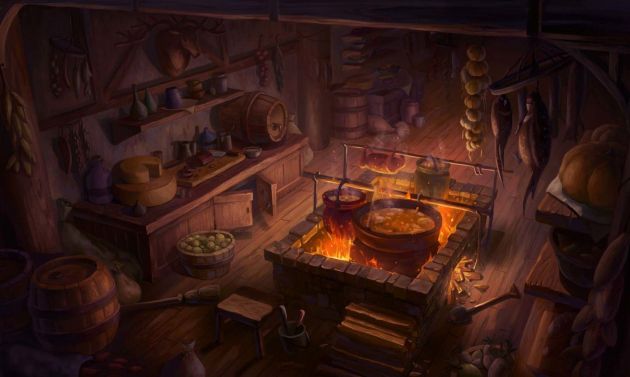Culinary Art (sage ability)
Culinary art is an authority-status sage ability that enables the character to produce food of a higher quality and taste than an ordinary cook, using the same materials. This improves the diner's experience, ensuring a far lower chance of a deleterious effect following the food's consumption.
Ingredients & Preparation
The taste of food derives in part from the ingredients used. Peasant food, like durables and staples, is surpassed by epicurean cuisine that's fresh and selective. Best of all, cosmopolitan, premium foods are sought after expressly for their taste and unusual cultivation.
Taste also depends on the ease of preparation. Cold camp fare, eaten in the outdoors, denies actual cooking of food; if a campfire is possible, the taste improves as well. Galley fare enables the benefits of a cookwagon or vardo; Scullery, the food that can be cooked in an ordinary kitchen. A guestkitchen is even better, as the environment is spacious and well-ventilated ... and finally, the lord's kitchen is best of all.
Taste
| Preparation | Ingredients | ||||
|---|---|---|---|---|---|
| Durable | Staple | Fresh | Selective | Premium | |
| cold camp | nosh | nosh | savoury | tasty | flavourful |
| campfire | savoury | tasty | flavourful | delicious | piquant |
| galley | tasty | flavourful | delicious | piquant | mouth-watering |
| scullery | tasty | delicious | piquant | mouth-watering | ambrosia |
| guestkitchen | flavourful | delicious | mouth-watering | ambrosia | ambrosia |
| lord's kitchen | flavourful | piquant | ambrosia | ambrosia | ambrosia |
A culinary artist is able to work with any food and in any environment — and is decisively able to make more with less. The table shows the various levels of "taste" that the culinary artist can produce. This version is similar to the table found on the nutrition & preparation of food page, but has been upgraded to express the results for a culinary artist.
In order of quality, "nosh" is agreeable food, encouraging the diner to scrape the remains from the plate; "savoury" has a sharper taste gives a feeling of being content and wholesomely satisfied; "tasty" is distinctly pleasurable and almost always calls for seconds; "flavourful" causes the diner to cease conversation and actively enjoy the taste of the food; "delicious" calls for the diner to share aloud the eating experience, declaring its noteworthiness; "piquant" is distinct and memorable, the sort of meal that one would certainly recall weeks later; "mouth-watering" cries for the food to be gobbled, even protected from others, as the diner cannot get enough; and "ambrosia" is simply ecstasy, eaten with eyes closed and at one with one’s pleasure.
Food that's described as "grub," hardly palatable but can be choked down for the sake of food, or "chow," about which at least the diner can be indifferent to the taste, are simply never produced by a culinary artist.
Efficacy
This describes the effect of the food upon the diner. With some foods, there's always a chance that a given diner simply won't like what the preparer has done; but in every case, food that's piquant, mouth-watering or ambrosia will never receive a bad opinion.
| Taste | Roll | ||||||||||
|---|---|---|---|---|---|---|---|---|---|---|---|
| 18 | 17 | 11-16 | 10 | 9 | 8 | 7 | 6 | 5 | 4 | 3 | |
| nosh | no effect | grumpy | tired | miserable | vomitous | diarrhetic | |||||
| savoury | no effect | grumpy | tired | miserable | vomitous | ||||||
| tasty | no effect | grumpy | tired | miserable | |||||||
| flavourful | no effect | grumpy | tired | ||||||||
| delicious | sated | no effect | grumpy | ||||||||
| piquant | sated | no effect | |||||||||
| mouth-watering | happy | sated | no effect | ||||||||
| ambrosia | elated | happy | sated | no effect | |||||||
To use the table, roll 3d6 and compare with the column numbers. Most often, food with have no special effect on the eater, which generally is a good thing.
See Also,
Cuisine (sage study)
Gastronomy (sage field)
